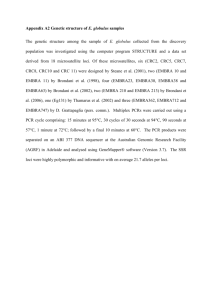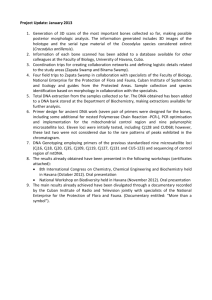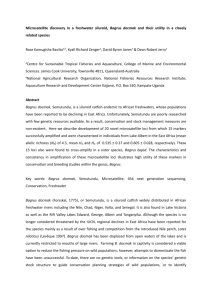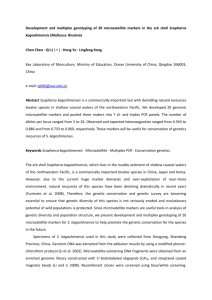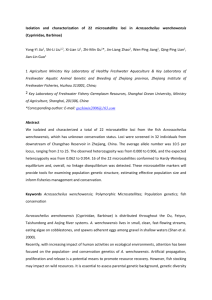1999 California Avocado Research Symposium pages 11-13
advertisement
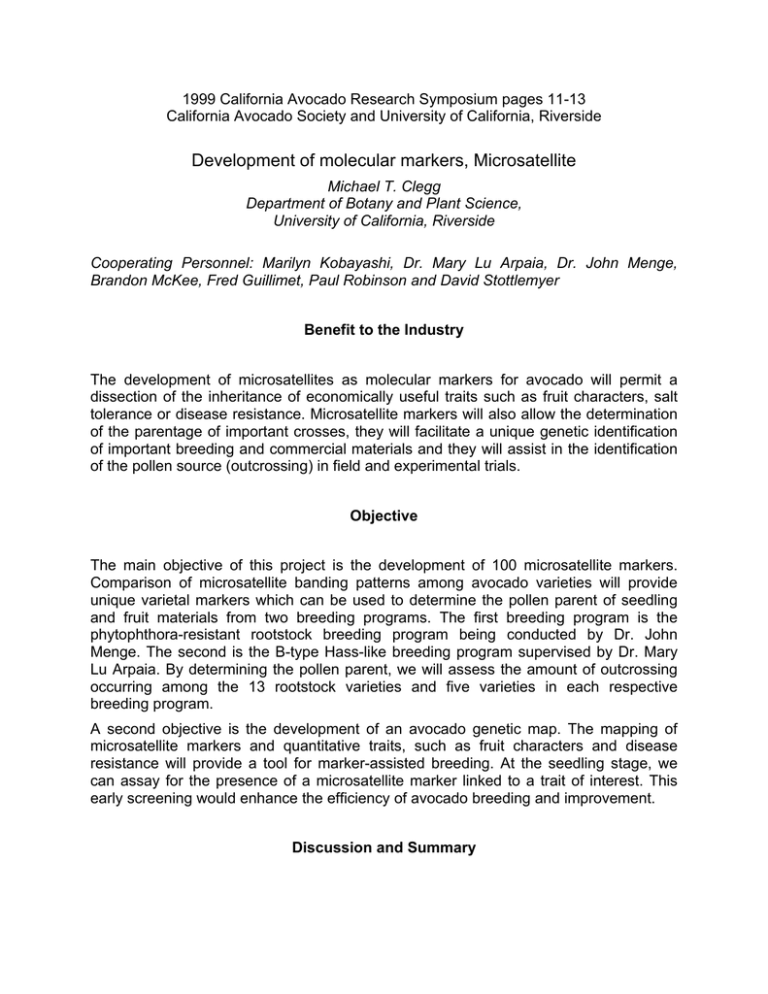
1999 California Avocado Research Symposium pages 11-13 California Avocado Society and University of California, Riverside Development of molecular markers, Microsatellite Michael T. Clegg Department of Botany and Plant Science, University of California, Riverside Cooperating Personnel: Marilyn Kobayashi, Dr. Mary Lu Arpaia, Dr. John Menge, Brandon McKee, Fred Guillimet, Paul Robinson and David Stottlemyer Benefit to the Industry The development of microsatellites as molecular markers for avocado will permit a dissection of the inheritance of economically useful traits such as fruit characters, salt tolerance or disease resistance. Microsatellite markers will also allow the determination of the parentage of important crosses, they will facilitate a unique genetic identification of important breeding and commercial materials and they will assist in the identification of the pollen source (outcrossing) in field and experimental trials. Objective The main objective of this project is the development of 100 microsatellite markers. Comparison of microsatellite banding patterns among avocado varieties will provide unique varietal markers which can be used to determine the pollen parent of seedling and fruit materials from two breeding programs. The first breeding program is the phytophthora-resistant rootstock breeding program being conducted by Dr. John Menge. The second is the B-type Hass-like breeding program supervised by Dr. Mary Lu Arpaia. By determining the pollen parent, we will assess the amount of outcrossing occurring among the 13 rootstock varieties and five varieties in each respective breeding program. A second objective is the development of an avocado genetic map. The mapping of microsatellite markers and quantitative traits, such as fruit characters and disease resistance will provide a tool for marker-assisted breeding. At the seedling stage, we can assay for the presence of a microsatellite marker linked to a trait of interest. This early screening would enhance the efficiency of avocado breeding and improvement. Discussion and Summary Microsatellites are composed of repeated motifs of di-, tri- and tetranucleotides (for example, ATATAT..., GCAGCAGCA..., or CATGCATGCATG....) and are distributed in high numbers throughout the genome of plants and animals. The codominant inheritance of microsatellite loci allows for the discrimination of homozygous and heterozygous individuals. This provides more genetic information on the contribution of each parental gamete. Using Hass avocado genomic DNA provided by our laboratory, a southern California company, Genetic Information Systems, used a selection procedure to isolate the DNA fragments containing microsatellites, producing an avocado microsatellite-enhanced library. Our laboratory is currently sequencing these DNA fragments to characterize the microsatellite locus present within the fragment. Short spans of DNA, called primers, are then designed to the two flanking regions surrounding the microsatellite locus. With the primer pairs, we will 1) compare microsatellite banding patterns of avocado varieties to obtain unique genetic identifier for a particular variety and 2) study recombination frequency using selfed avocado progeny to the determine mapping positions of microsatellite loci. After screening 500 DNA fragments from the enhanced library, our laboratory has developed primer pairs for 111 microsatellite loci (Table 1). Analysis of these microsatellite loci will lead to the development of a unique microsatellite banding profile for each avocado variety for the 13 varieties of the phytophthora resistant rootstock breeding program and the five varieties of the B-type Hass-like breeding program. These unique profiles will be used to determine the pollen parent for each fruit and seedling collected in the two breeding programs. Also two populations of selfed progeny, one Hass and the other Zutano, will be used to determine the recombination frequency among microsatellite loci. The recombination frequency can be used as a quantitative index of the linear distance between two loci and lead to the positioning of the microsatellite loci to form an avocado genetic map. Sequence of the 332 DNA fragments were compared to the sequence of known genes in a nucleotide/protein database, called GenBank. The sequence from sixteen DNA fragments were found to have close similarities to known genes in the database (Table 2). These genes, along with the linked microsatellite loci, will be positioned on the avocado genetic. Long term goals for the microsatellite markers are the development of unique profiles for avocado varieties that are important breeding and commercial materials and the development of a genetic map with 100 microsatellite loci and associated genes. Our laboratory has extracted embryo DNA from 720 Hass fruit collected from the B-type Hass-like plot in Ventura county. For the phytophthora resistant rootstock breeding program, extraction of leaf DNA from 394 seedlings is completed. Once the appropriate varietal microsatellite markers have been identified, we will analyze the DNA samples to determine the parentage of the fruit/seedling. The data on parentage will serve as a guide for outcrossing in the B-type Hass-like breeding program and the phytophthora resistant rootstock breeding program. For the genetic map, we previously isolated DNA from leaf material of the 106 selfed Hass progeny. We are currently extracting DNA from 131 selfed Zutano progeny. Using the selfed progeny, we will determine the recombination frequency to position the microsatellite loci on a genetic map. The map will provide a tool for marker-assisted breeding and allow for early screening of economically important traits, enhancing the efficiency of avocado breeding and improvement.

